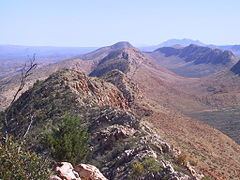Area 39,294 km² | Length 644 km (400 mi) E/W Elevation 1,531 m Highest point Mount Zeil Age of rock Carboniferous | |
 | ||
Mountains | ||
West macdonnell ranges
The MacDonnell Ranges, a mountain range and an interim Australian bioregion, is located in the Northern Territory, comprising 3,929,444 hectares (9,709,870 acres). The range is a 644 km (400 mi) long series of mountains located in the centre of Australia, and consist of parallel ridges running to the east and west of Alice Springs. The mountain range contains many spectacular gaps and gorges as well as areas of Aboriginal significance.
Contents
- West macdonnell ranges
- Map of Macdonnell Ranges Hugh NT 0872 Australia
- Geography
- Geology
- Ecology
- Tourist attractions
- References
Map of Macdonnell Ranges, Hugh NT 0872, Australia
The ranges were named after Sir Richard MacDonnell (the Governor of South Australia at the time) by John McDouall Stuart, whose 1860 expedition reached them in April of that year. The Horn Expedition investigated the ranges as part of the scientific expedition into central Australia. Other explorers of the range included David Lindsay and John Ross.
The MacDonnell Ranges were often depicted in the paintings of Albert Namatjira.
Geography
The highest peaks are Mount Zeil with an elevation of 1,531 metres (5,023 ft) AHD, Mount Liebig at 1,524 metres (5,000 ft) AHD, Mount Edward at 1,423 metres (4,669 ft), Mount Giles at 1,389 metres (4,557 ft) and Mount Sonder at 1,380 metres (4,530 ft) AHD; the five highest mountains in the Northern Territory. The headwaters of the Todd, Finke and Sandover rivers form in the MacDonnell Ranges. The range is crossed by the Australian Overland Telegraph Line and the Stuart Highway.
Geology
350-300 million years ago a mountain building event created the MacDonnell Ranges. Since that time, folding, faulting and erosion have shaped the range and created numerous gaps and gorges. The ranges are composed of many rock types, but are most famous for their red quartzite peaks and gorges. Other rock types include granite, limestone, sandstone and siltstone. Some of the valleys of the range contain fossil evidence of the inland sea that once covered central Australia.
Ecology
Part of the Central Ranges xeric scrub ecoregion of dry scrubby grassland the ranges are home to a large number of endemic species including the Centralian Tree Frog. This is mostly due to the micro climates that are found around the cold rock pools.
Tourist attractions
The West MacDonnell National Park was established in 1984 to protect the numerous parks and reserves of the range,including internal residents inside the range. It also facilitated the development of the Larapinta Trail.
To the east of Alice Springs, within an hours drive, are sites important to the local Arrernte people, many of which contain examples of Aboriginal rock art. These include Emily Gap, Jessie Gap, Trephina Gorge and N’Dhala Gorge.
To the west of Alice Springs is the Larapinta Trail—a world-class, long distance bush walking trail that runs 223 kilometres (139 mi) along the backbone of the range. Along the trail is Simpsons Gap, Standley Chasm, Ellery Creek Big Hole, Serpentine Gorge, Ochre Pits, Ormiston Pound, Redbank Gorge, Glen Helen Gorge, Tnorala Gosse Bluff, Palm Valley, Mount Sonder, Mount Zeil and Mount Giles.
